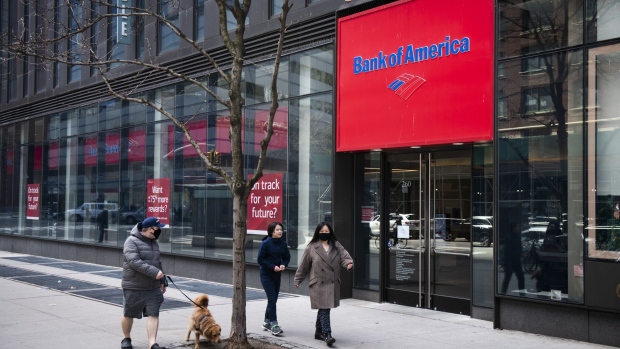Apr 15, 2020
BofA joins rival banks in setting aside billions for loan losses
, Bloomberg News

Bank of America Corp. followed two big rivals in setting aside billions of dollars for loans likely to sour amid an almost total U.S. economic shutdown.
Profit plunged 45 per cent as the company allocated US$4.76 billion for loan losses, the most since 2010, as businesses and households reel from the coronavirus pandemic. The bank joins competitors JPMorgan Chase & Co. and Wells Fargo & Co., which posted their highest provisions in a decade Tuesday. The three lenders have collectively stashed away more than US$17 billion to cover defaults.
Banks are trying to get ahead of loan losses they expect to come from the pandemic bringing large swaths of the global economy to a virtual standstill. While defaults haven’t yet spiked in a meaningful way, bank efforts to build up their reserves show they’re bracing for a severe recession.
“Despite increasing our loan loss reserves, we earned US$4 billion this quarter, maintained a significant buffer against our most stringent capital requirement, and ended the quarter with more liquidity than when we began,” Chief Executive Officer Brian Moynihan said in a statement.
The bank’s shares dropped 2.6 per cent to US$23.11 at 6:54 a.m. in early New York trading. The stock was down 33 per cent this year through Tuesday.
Moynihan has been a prominent voice in business since the Covid-19 crisis began, appearing alongside other bank CEOs at the White House in early March to discuss its economic impact. He’s pledged to retain staff and boost pay, and highlighted the lender’s forbearance efforts and its participation in the government’s small-business rescue program.It hasn’t all gone smoothly.
Despite being the first bank to accept applications for the rescue program, the company is fending off a lawsuit for favoring existing borrowers. Last week, CNBC and the New York Times reported Bank of America’s sales and trading staff are facing pressure to come to the office even as they become increasingly concerned about the spread of the virus.
The bank’s first-quarter provision for credit losses was almost five times the US$1 billion it set aside a year earlier. On top of the worse economic picture, banks are adopting a new accounting standard this year known as CECL, which requires them to set aside provisions earlier in a cycle.
Net interest income -- revenue from customers’ loan payments minus what the company pays depositors -- fell 2 per cent to US$12.1 billion in the first quarter.
On a fully taxable-equivalent basis, the figure was US$12.3 billion, exceeding the US$11.7 billion average estimate of nine analysts in a Bloomberg survey.
Trading revenue jumped more than expected as the firm benefited from volatile markets and active clients.Chief Financial Officer Paul Donofrio said in January that he expected NII to be lower in the first half as the Federal Reserve’s rate cuts work their way into the bank’s results.
That was well before the Fed made additional emergency rate cuts in response to the coronavirus-related shutdowns across the country.Also in the fourth-quarter results:
- The bank’s efficiency ratio, a measure of profitability, remained at 59 per cent, the same as in the fourth quarter of 2019.
- Net income fell to US$4.01 billion from US$7.31 billion a year earlier. Earnings per share totaled 40 cents, missing the 54-cent average estimate of 19 analysts.






